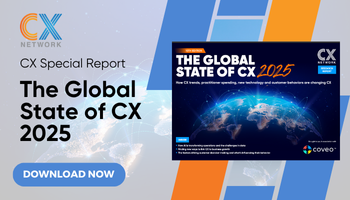Top 5 strategic aims in CX in 2025
Find out how respondents to the Global State of CX 2025 survey prioritized their strategic aims in CX
Add bookmark
Customer experience (CX) is the sum of all the interactions a person has with a brand, and the strategic aims of CX are paramount because they are the building blocks of making those connections. However, if CX leaders want to ensure continuous support for their initiatives, they must align their work with business objectives.

Don't miss any news, updates or insider tips from CX Network by getting them delivered to your inbox. Sign up to our newsletter and join our community of experts.
Respondents of the Global State of CX 2025 shared their top three priorities for strategic aims and this is what they prioritized:
- Grow the customer base (37 percent)
- Drive more sales (33 percent)
- Increase net promoter score, customer satisfaction, etc. (30 percent)
- Develop AI/generative AI capabilities (28 percent)
- Retain more customers (28 percent)

Don't miss any news, updates or insider tips from CX Network by getting them delivered to your inbox. Sign up to our newsletter and join our community of experts.
Grow the customer base
Growing the customer base was the top strategic aim of respodents to the survey. After all, providing exceptional CX is one way to attract customers and grow brand reputation. Seamless onboarding, personalized marketing and strong digital presence are a few examples of the tactics that work to grow the base. Artificial intelligence (AI) is swiftly advancing and enabling all those initiatives and more. But keeping the human touch is a vital part of building relationships and trust to grow the base - and win loyalty.
Zendesk sums it up like this:
"The most obvious reason a company should strive to grow their customer base is the potential for increased revenue. More customers mean more sales and more business-related benefits like:
Stability: When most of your sales come from a small number of customers, losing even one can have a huge negative impact. Diversification reduces that risk and leads to greater stability.
Economies of scale: Manufacturing is more affordable when you can do it in greater quantities. Reduce your operating costs and gain higher profit margins.
Competitive advantage: When operating costs decrease, you can sell at discounted prices, undercutting competitors and further increasing your customer base. Alternatively, you can leverage your authority in the market by negotiating better prices with your competitors."
Drive more sales
Ultimately, sales are the most direct line between CX and the bottom line. And digital touchpoints like apps and social media are making it easier than ever for CX to have an impact on sales. End-to-end CX begins when potential customer start shopping. Curating interactions as people start searching for a product or service they need or want is is the contribution CX leaders make to sales.
In 2024, 87 percent of customers were likely to recommend a brand or company to friends and family if it provided a convenient customer service experience, according to the ACA Study.
Increase NPS, CSAT, etc.
CX metrics are important because of the fact that initiatives will only continue if business leaders see evidence of return on investment (ROI). Many CX leaders rely on the stalwarts: Net promoter score (NPS) and customer satisfaction (CSAT).
NPS is measuring and tracking the percentage of customers who are promoters (loyal enthusiasts) versus detractors (unhappy customers), according to the CX Network guide. Recently, some experts have questioned the worth of NPS and other metrics as AI in CX has propelled other key performance indicators. CX Network contributor Claire Cunningham recently shared a column about the problem with NPS:
"Executives loved it because it was simple; consultants loved it because executives loved it. It seemed like we finally had the commercial metric that measured CX as a financial number. Suddenly every boardroom wanted to know their NPS.
The problem is that popularity does not equal accuracy. It became a corporate comfort blanket, easy to explain in a slide deck, and words like “promoter” sounded like dollar signs. But it was never designed to capture the complexity of real experiences, and we are paying for it now as organizations and as customers."
CSAT is the measurement of how satisfied customers are with a specific product, service or interaction with a company or brand. Usually, CX leaders arrive at this KPI through surveys. This measurement also has received some criticism. And the future may bring different KPIs to the forefront as AI impacts customer insights and data analytics.
Develop AI/generative AI capabilities
AI continues to take the CX world by storm. To maintain a competitive advantage, companies must understand how to incorporate AI so it increases efficiency, decreases friction and brings down costs without interfering with the human touch. Finding the right tools and training staff are a necessity. But AI is already collaborating with human agents to help do some of the heavy lifting for customer support.
“AI agents can gather information on the interaction and case history and propose more complete and accurate solutions than has been possible with previous generations of technology, such as machine learning," said Andreas Welsch, author of AI Leadership Handbook, in the Practical guide to AI agents. "Agents can provide answers to the most common questions and thereby support in triaging.”
Retain more customers
Tied with developing AI/generative AI capabilities, retaining more customers is an all-encompassing strategic aim. Ultimately, the goals that are higher in the list ideally lead to this one. Of course, some customers will be a one-off. They will purchase a product or service once, fulfill their need and move on. But if a brand can win a customer's loyalty, it can ensure repeat business, good word of mouth and a long-lasting relationship, which can pay dividends.
"In today’s world, satisfaction keeps you in the game, but loyalty wins championships,” said Raluca Berchiu, founder and CEO of CXM | Strategic, in the Global State report. “Here’s the hard truth: your customers don’t care about your brand story until it becomes part of their own story. Loyalty isn’t built on products or flashy campaigns – it is built on trust.”
Tenth annual flagship report. AI has transformed CX, raising expectations with investment in AI for CX automation, machine learning, and conversational AI now a top priority. Download the Global State of CX to learn how the industry is preparing for the new AI first future.Special Report: The Global State of CX


























